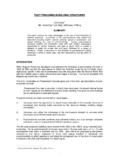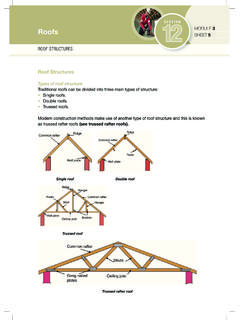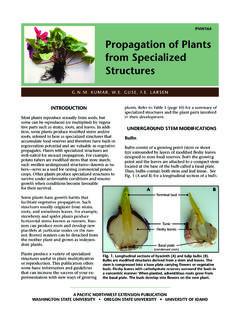Transcription of Open Data Structures
1 open data Structures (in C++). Edition . Pat Morin Contents Acknowledgments ix Why This Book? xi Preface to the C++ Edition xiii 1 Introduction 1. The Need for Efficiency .. 2. Interfaces .. 4. The Queue, Stack, and Deque Interfaces .. 5. The List Interface: Linear Sequences .. 6. The USet Interface: Unordered Sets .. 8. The SSet Interface: Sorted Sets .. 8. Mathematical Background .. 9. Exponentials and Logarithms .. 10. Factorials .. 11. Asymptotic Notation .. 12. Randomization and Probability .. 15. The Model of Computation .. 18. Correctness, Time Complexity, and Space Complexity .. 19. Code Samples .. 22. List of data Structures .. 22. Discussion and Exercises .. 25. 2 Array-Based Lists 29. ArrayStack: Fast Stack Operations Using an Array .. 31. The Basics .. 31. Contents Growing and Shrinking .. 34. Summary .. 36. FastArrayStack: An Optimized ArrayStack .. 36. ArrayQueue: An Array-Based Queue.
2 37. Summary .. 41. ArrayDeque: Fast Deque Operations Using an Array .. 41. Summary .. 43. DualArrayDeque: Building a Deque from Two Stacks .. 44. Balancing .. 47. Summary .. 49. RootishArrayStack: A Space-Efficient Array Stack .. 50. Analysis of Growing and Shrinking .. 54. Space Usage .. 55. Summary .. 56. Computing Square Roots .. 56. Discussion and Exercises .. 59. 3 Linked Lists 63. SLList: A Singly-Linked List .. 63. Queue Operations .. 65. Summary .. 66. DLList: A Doubly-Linked List .. 67. Adding and Removing .. 69. Summary .. 70. SEList: A Space-Efficient Linked List .. 71. Space Requirements .. 73. Finding Elements .. 73. Adding an Element .. 75. Removing an Element .. 78. Amortized Analysis of Spreading and Gathering .. 80. Summary .. 81. Discussion and Exercises .. 82. 4 Skiplists 87. The Basic structure .. 87. SkiplistSSet: An Efficient SSet .. 89. iv Summary.
3 92. SkiplistList: An Efficient Random-Access List .. 93. Summary .. 98. Analysis of Skiplists .. 98. Discussion and Exercises .. 102. 5 Hash Tables 107. ChainedHashTable: Hashing with Chaining .. 107. Multiplicative Hashing .. 110. Summary .. 114. LinearHashTable: Linear Probing .. 114. Analysis of Linear Probing .. 117. Summary .. 121. Tabulation Hashing .. 121. Hash Codes .. 122. Hash Codes for Primitive data Types .. 123. Hash Codes for Compound Objects .. 123. Hash Codes for Arrays and Strings .. 125. Discussion and Exercises .. 128. 6 Binary Trees 133. BinaryTree: A Basic Binary Tree .. 135. Recursive Algorithms .. 136. Traversing Binary Trees .. 136. BinarySearchTree: An Unbalanced Binary Search Tree .. 139. Searching .. 140. Addition .. 141. Removal .. 144. Summary .. 146. Discussion and Exercises .. 146. 7 Random Binary Search Trees 153. Random Binary Search Trees.
4 153. Proof of Lemma .. 156. Summary .. 158. Treap: A Randomized Binary Search Tree .. 159. v Contents Summary .. 166. Discussion and Exercises .. 168. 8 Scapegoat Trees 173. ScapegoatTree: A Binary Search Tree with Partial Rebuild- ing .. 174. Analysis of Correctness and Running-Time .. 178. Summary .. 180. Discussion and Exercises .. 181. 9 Red-Black Trees 185. 2-4 Trees .. 186. Adding a Leaf .. 187. Removing a Leaf .. 187. RedBlackTree: A Simulated 2-4 Tree .. 190. Red-Black Trees and 2-4 Trees .. 190. Left-Leaning Red-Black Trees .. 194. Addition .. 196. Removal .. 199. Summary .. 205. Discussion and Exercises .. 206. 10 Heaps 211. BinaryHeap: An Implicit Binary Tree .. 211. Summary .. 215. MeldableHeap: A Randomized Meldable Heap .. 217. Analysis of merge(h1, h2) .. 220. Summary .. 221. Discussion and Exercises .. 222. 11 Sorting Algorithms 225. Comparison-Based Sorting.
5 226. Merge-Sort .. 226. Quicksort .. 230. Heap-sort .. 233. A Lower-Bound for Comparison-Based Sorting .. 235. Counting Sort and Radix Sort .. 238. vi Counting Sort .. 239. Radix-Sort .. 241. Discussion and Exercises .. 243. 12 Graphs 247. AdjacencyMatrix: Representing a Graph by a Matrix .. 249. AdjacencyLists: A Graph as a Collection of Lists .. 252. Graph Traversal .. 256. Breadth-First Search .. 256. Depth-First Search .. 258. Discussion and Exercises .. 261. 13 data Structures for Integers 265. BinaryTrie: A digital search tree .. 266. XFastTrie: Searching in Doubly-Logarithmic Time .. 272. YFastTrie: A Doubly-Logarithmic Time SSet .. 275. Discussion and Exercises .. 280. 14 External Memory Searching 283. The Block Store .. 285. B-Trees .. 285. Searching .. 287. Addition .. 290. Removal .. 295. Amortized Analysis of B-Trees .. 301. Discussion and Exercises .. 304. Bibliography 309.
6 Index 317. vii Acknowledgments I am grateful to Nima Hoda, who spent a summer tirelessly proofread- ing many of the chapters in this book; to the students in the Fall 2011. offering of COMP2402/2002, who put up with the first draft of this book and spotted many typographic, grammatical, and factual errors; and to Morgan Tunzelmann at Athabasca University Press, for patiently editing several near-final drafts. ix Why This Book? There are plenty of books that teach introductory data Structures . Some of them are very good. Most of them cost money, and the vast majority of computer science undergraduate students will shell out at least some cash on a data Structures book. Several free data Structures books are available online. Some are very good, but most of them are getting old. The majority of these books be- came free when their authors and/or publishers decided to stop updat- ing them.
7 Updating these books is usually not possible, for two reasons: (1) The copyright belongs to the author and/or publisher, either of whom may not allow it. (2) The source code for these books is often not avail- able. That is, the Word, WordPerfect, FrameMaker, or LATEX source for the book is not available, and even the version of the software that han- dles this source may not be available. The goal of this project is to free undergraduate computer science stu- dents from having to pay for an introductory data Structures book. I have decided to implement this goal by treating this book like an open Source software project. The LATEX source, C++ source, and build scripts for the book are available to download from the author's website1 and also, more importantly, on a reliable source code management The source code available there is released under a Creative Commons Attribution license, meaning that anyone is free to share: to copy, dis- tribute and transmit the work; and to remix: to adapt the work, including the right to make commercial use of the work.
8 The only condition on these rights is attribution: you must acknowledge that the derived work contains code and/or text from 1 2 xi Why This Book? Anyone can contribute corrections/fixes using the git source-code management system. Anyone can also fork the book's sources to develop a separate version (for example, in another programming language). My hope is that, by doing things this way, this book will continue to be a use- ful textbook long after my interest in the project, or my pulse, (whichever comes first) has waned. xii Preface to the C++ Edition This book is intended to teach the design and analysis of basic data struc- tures and their implementation in an object-oriented language. In this edition, the language happens to be C++. This book is not intended to act as an introduction to the C++ pro- gramming language. Readers of this book need only be familiar with the basic syntax of C++ and similar languages.
9 Those wishing to work with the accompanying source code should have some experience program- ming in C++. This book is also not intended as an introduction to the C++ Stan- dard Template Library or the generic programming paradigm that the STL embodies. This book describes implementations of several different data Structures , many of which are used in implementations of the STL. The contents of this book may help an STL programmer understand how some of the STL data Structures are implemented and why these imple- mentations are efficient. xiii Chapter 1. Introduction Every computer science curriculum in the world includes a course on data Structures and algorithms. data Structures are that important; they im- prove our quality of life and even save lives on a regular basis. Many multi-million and several multi-billion dollar companies have been built around data Structures .
10 How can this be? If we stop to think about it, we realize that we inter- act with data Structures constantly. open a file: File system data Structures are used to locate the parts of that file on disk so they can be retrieved. This isn't easy; disks contain hundreds of millions of blocks. The contents of your file could be stored on any one of them. Look up a contact on your phone: A data structure is used to look up a phone number in your contact list based on partial information even before you finish dialing/typing. This isn't easy; your phone may contain information about a lot of people everyone you have ever contacted via phone or email and your phone doesn't have a very fast processor or a lot of memory. Log in to your favourite social network: The network servers use your login information to look up your account information. This isn't easy; the most popular social networks have hundreds of mil- lions of active users.







